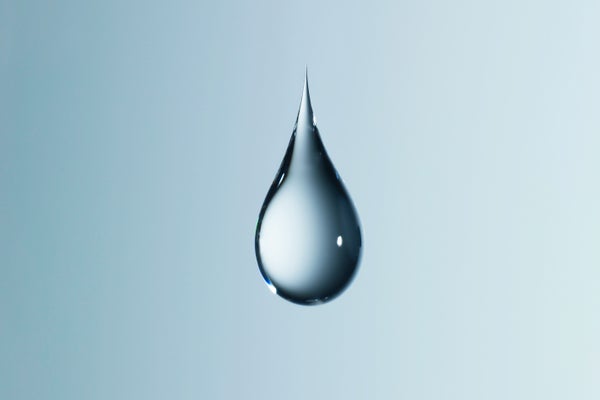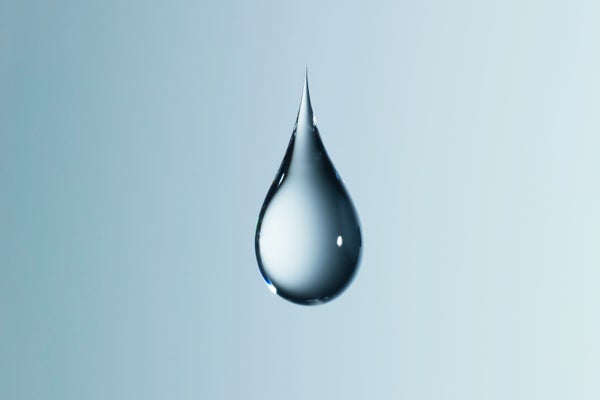November 7, 2024
5 min read
Rainwater Could Help Satisfy AI’s Water Demands
A few dozen ChatGPT queries cost a bottle’s worth of water. Tech firms should consider simpler solutions, like harvesting rainwater, to meet AI’s needs

In late September Microsoft announced that it had reached a deal to reopen the Three Mile Island nuclear plant to power its growing network of data centers. Reviving the plant, home to a partial meltdown in 1979, is one of several extraordinary moves that tech companies are willing to make to meet the increasing energy demands of artificial intelligence, cloud computing and other technologies. Industry analysts at Transforma Insights predict the world will reach nearly 30 billion Internet of Things devices by 2030—up from less than 10 billion in 2020.
Still, as big tech companies tout nuclear power and other low-carbon energy plans, they’ve presented surprisingly few ideas to meet their rapidly growing use of another scarce resource: water.
Data centers require massive amounts of water for liquid cooling systems to absorb and dissipate the heat generated by servers. Researchers at the University of California, Riverside, have found that between five and 50 ChatGPT requests can consume up to 500 milliliters of water (close to the amount in a 16-ounce bottle). Those gulps add up. Google used 20 percent more water in 2022 compared to 2021 as it ramped up AI development. Microsoft’s water use rose by 34 percent over the same period. By 2027 the amount of water AI uses in one year worldwide is projected to be on par with what a small European nation consumes. Worse, large numbers of data centers are located in water-stressed regions. Recently, a Google-owned data center in The Dalles, Oregon commanded one third of the city’s water supply amid drought conditions.
On supporting science journalism
If you’re enjoying this article, consider supporting our award-winning journalism by subscribing. By purchasing a subscription you are helping to ensure the future of impactful stories about the discoveries and ideas shaping our world today.
While some tech companies are making investments in water recycling, others are imagining long-shot innovations such as transporting seawater inland or even moving data centers under the ocean. Many are simply ignoring what their water use could eventually cost, not to mention the specter of drought. To date, only a few tech companies have taken steps to apply what might be the simplest, most proven and most promising strategy to mitigate water risks: catching rainwater from the sky.
People have been gathering rainwater since ancient times. Now there’s growing interest among water conservation advocates to collect rain from rooftops and send it down gutters into tanks. Then, at data centers, this water would be piped through cooling systems. Recent studies show that harvesting even a small portion of the rain that falls in a given area can eliminate water shortages while simultaneously recharging groundwater and reducing pollution from stormwater runoff. There’s no utility middleman needed when water is collected from a roof, meaning rainwater harvesting can be less expensive than purchasing equivalent amounts from a municipal supply—and avoid the greenhouse emissions associated with pumping water between sites.
For years some states and municipalities restricted residential and industrial rainwater harvesting because of concerns about water quality or reductions in the water supply. But more recently state after state has authorized the practice as evidence for conservation benefits mounts. Cities like Tucson and Austin are now encouraging rainwater collection by offering incentives and establishing requirements. Apple, Ford and Toyota have recently integrated rainwater harvesting systems into corporate campuses and manufacturing facilities.
But we believe that data centers are the biggest untapped opportunity for water conservation through rainwater harvesting. It’s not just that data centers have the pressing need for water—it’s also that their large, flat roofs are well-suited to harvest water. A 50,000-square-foot roof can collect about 31,000 gallons of water from a single inch of rain—about as much as fills an average residential swimming pool. Many data centers feature roofs larger than 100,000 square feet, and some hyperscale data centers owned by major tech companies feature roofs of up to one million square feet.
Why aren’t more data centers relying on rainwater harvesting? The cost, for one. Setting up a system for a commercial facility like a data center typically costs between $2 to $5 per square foot, depending on the system’s complexity, storage and filtration needs. If the cost of municipal water in an area is low, it might not make sense to invest in rainwater capture. What’s more, rainwater systems rarely cover the total amount of water needed to cool a data center. Some massive facilities can consume a million gallons of water daily.
But the economics of rainwater harvesting make more and more sense as both the cost and uncertainty of water resources increase, especially as the climate changes. Much like installing solar panels, installing a rainwater harvesting system is a one-time investment that reduces long-term utility costs. In some cases companies can leverage their existing stormwater management budgets toward rainwater harvesting. In places such as the greater Dallas area, home to many of the nation’s data centers, rainfall averages means that rainwater harvesting systems could cover up to a third of a data center’s cooling needs—depending on size and storage systems. While the numbers are lower in arid regions, higher costs of water in those areas typically make the economics of rainwater harvesting more attractive. As public concern grows about the environmental effects of AI and other technologies, companies will likely need to consider both the financial and reputational risks of inaction on water.
Some industry leaders are beginning to see the potential. A Google data center in South Carolina is using rainwater retention ponds for harvesting rainwater. A Microsoft data center has implemented rainwater harvesting in Sweden, reducing reliance on local water sources. Amazon Web Services highlights the potential of rainwater harvesting in its water positive strategy.
On a policy level, green banks—the clean energy-focused financial institutions that are expanding all over the country following a $27 billion federal investment through the Inflation Reduction Act—could soon start helping to provide financing for rainwater projects. Rainwater has potential to win bipartisan support—and potentially even tax credits along the lines of recent renewables legislation. While the approach can be a popular cause among Democrats on climate resilience grounds, Republicans can support rainwater harvesting without needing to accept the science of climate change or oppose fossil fuel lobbies.
At a time when Silicon Valley is turning to energy solutions like long-dormant nuclear plants, it might seem odd to address a pressing global challenge using a technology that’s as old as civilization itself. But sometimes the best solutions can fall out of the sky.
This is an opinion and analysis article, and the views expressed by the author or authors are not necessarily those of Scientific American.

